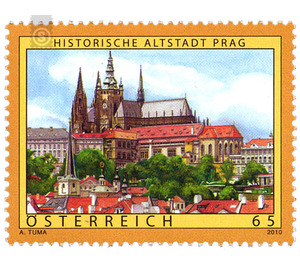Old Austria - Austria / II. Republic of Austria 2010 - 65 Euro Cent
Theme: Architecture
| Country | Austria / II. Republic of Austria |
| Issue Date | 2010 |
| Face Value | 65.00 |
| Edition Issued | 200,000 |
| Printing Type | offset |
| Stamp Type | Commemorative |
| Item Type | Stamp |
| Chronological Issue Number | 2198 |
| Chronological Chapter | OOS-OE2 |
| SID | 387765 |
| In 62 Wishlists | |
The history of Prague, today the capital and at the same time the most populous place in the Czech Republic, dates back to the Paleolithic, the Prague Basin was one of the most densely populated landscapes in Bohemia during the whole of prehistoric times. In the 13th century, King Wenceslas I gave Prague the city rights, his son Premysl Ottokar II founded the first Prague Neustadt, today's Lesser Town. Under Emperor Charles IV and his son Wenceslas IV, the city flourished as the imperial seat of the Holy Roman Empire, in 1348 the first university in Central Europe was founded here. With the construction of the new town in the same year, Prague was the fourth largest city north of the Alps with more than 40,000 inhabitants. At the end of the 16th century, Emperor Rudolf II restored Prague to its seat of residence, while splendid Baroque palaces and churches still bear witness to it today. The second Prague lintel triggered the Thirty Years 'War, and the Seven Years' War also left its mark. During the 19th century, Prague experienced a great cultural boom, including the National Museum and the National Theater. Around 1860, Prague lost its existing since the Middle Ages German or German-speaking majority population, 1930 were only 42,000 Prague German as their mother tongue. Around 1900, cosmopolitan Prague was a popular place for artists and writers (Franz Kafka, Max Brod, Rainer Maria Rilke, Franz Werfel and others) - at that time, Prague was a city of the multi-national state of Austria-Hungary characterized by an intensive exchange between nationalities. Prague was occupied by the German Reich in 1939, and around 120,000 Jews lived in the Bohemian lands at the time. Immediately after the end of the war, the Prague Germans were expelled almost without exception - many of them were interned, many killed. Throughout the twentieth century, Prague retained the status of a European metropolis, and neither the German nor the Soviet occupation could have affected this fact. In the so-called "Prague Spring" (1968), a peaceful attempt was made to replace authoritarian socialism with a socialism with a human face, but this was crushed by the Warsaw Pact forces at gunpoint. In 1989, Prague was then the scene of the "Velvet Revolution" - it meant the end of the socialist regime in the then Czechoslovakia. Today about 1.2 million people live in the "Golden City". In addition to the main industry, tourism, Prague also has a sizeable manufacturing industry. The authentic brand image shows a historical image of the world-famous Prague Castle (Pražský hrad) with its towering St. Vitus Cathedral.


